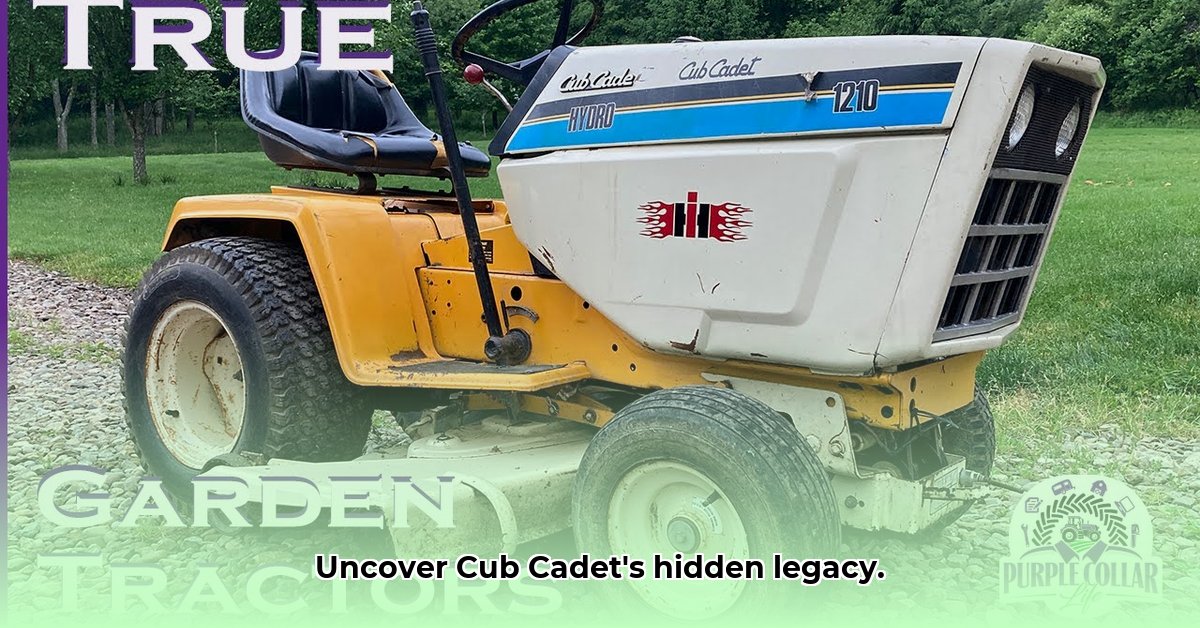
A Blast from the Past: The Cub Cadet Story
The enduring appeal of old Cub Cadet garden tractors stems from a rich history intertwined with agricultural machinery giants. Initially associated with International Harvester, Cub Cadet inherited a reputation for robust construction and reliability. This legacy continued under MTD's ownership, although the company navigated significant industry shifts, including notable factory closures like the Brownsville plant in 2009. These events shaped the brand's evolution and current market position, yet the enduring popularity of these tractors speaks volumes about their inherent quality and the nostalgia they evoke. For more in-depth information, check out this detailed Cub Cadet history. But what specific factors contribute to their sustained market presence?
The Market for Vintage Power: Why Are They Still So Popular?
The used tractor market shows surprisingly strong demand for vintage Cub Cadets. Their robust build quality, exceeding that of many modern counterparts, is a primary driver. However, sentimentality also plays a significant role, with many viewing these tractors as cherished family heirlooms. The condition of the tractor and the availability of replacement parts are crucial determinants of value. A meticulously maintained Cub Cadet commands a premium; conversely, a neglected machine depreciates significantly. What specific features drive higher collector values remains an area requiring further investigation. How does the availability of parts influence the pricing of these vintage machines?
Who Wins? Examining the Impact on Different Groups
The enduring popularity of vintage Cub Cadets benefits multiple stakeholders. MTD, as the current brand owner, profits from consistent parts sales, maintaining a revenue stream and reinforcing the Cub Cadet brand image. Dealers specializing in vintage equipment also see high demand and premium pricing, building clientele around specialized expertise. Owners and collectors benefit from owning durable, reliable equipment that holds its value, creating a tangible return on investment. This interconnected system creates a win-win-win scenario. But how sustainable is this model in the long term?
| Stakeholder | Immediate Benefits | Long-Term Prospects | Potential Challenges |
|---|---|---|---|
| MTD (Cub Cadet) | Consistent parts sales; strong brand image | Diversification into related markets; sustainable practices | Maintaining a consistent supply chain; managing fluctuating demand |
| Vintage Equipment Dealers | High demand, premium pricing, specialized expertise | Expansion of services; development of a loyal customer base | Sourcing parts; competition from newer online marketplaces |
| Owners/Collectors/Farmers | Reliable equipment, potential appreciation in value | Sense of connection to the past; access to a proven workhorse | Finding parts; higher repair costs potentially than newer equipment |
The Environmental Side of Things: A Sustainable Legacy?
The environmental impact of vintage Cub Cadets warrants careful consideration. Their longevity reduces landfill waste compared to frequent replacements. However, a comprehensive lifecycle assessment is crucial, encompassing manufacturing, transportation of parts, and eventual disposal. Responsible maintenance and repair practices, however, significantly minimize their ecological footprint. How do the environmental effects of a vintage Cub Cadet compare to the lifecycle impact of modern alternatives? Further research is needed to fully quantify this.
How to Calculate Total Cost of Ownership for a Used Cub Cadet Tractor
Understanding the total cost of ownership (TCO) is paramount when purchasing a used Cub Cadet. Factors beyond the initial purchase price significantly impact long-term expenses. Careful financial planning minimizes surprises and maximizes the machine's lifespan.
Calculating Total Cost of Ownership (TCO): A Step-by-Step Guide
- Purchase Price: Negotiate a fair price based on the tractor's condition.
- Depreciation: Estimate annual depreciation based on age and condition. Utilize online resources and dealer expertise.
- Insurance: Factor in annual premiums.
- Taxes: Account for any applicable property taxes.
- Maintenance: Budget for regular servicing, repairs, and part replacements; parts availability is key.
- Fuel Costs: Estimate fuel consumption based on usage.
- Storage: Consider storage costs if applicable.
- Labor: Include labor costs for outsourced repairs.
A spreadsheet can effectively track these costs over time, aiding in expense prediction and informed decision-making.
Stakeholder Perspectives and Sustainability
- Buyers: Thorough TCO calculation is essential, balancing longevity against initial purchase price.
- Sellers: Accurate assessment of condition and part availability ensures fair pricing.
- Dealers: Providing transparent information about parts and repair costs builds trust.
The durability of Cub Cadets inherently contributes to sustainability by extending their useful life and reducing waste. However, fuel consumption and the environmental effects of part production and disposal still need complete analysis.
Further Research: Unanswered Questions
Future research should focus on several key areas: A comparative TCO analysis across different Cub Cadet models and competing brands is essential. A thorough environmental impact assessment throughout the various stages of the tractor's lifecycle is needed for a complete picture. Finally, tracking market share fluctuations over time will provide insights into the brand's long-term success and resilience. These investigations will create a detailed understanding of this unique niche market.